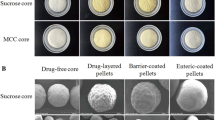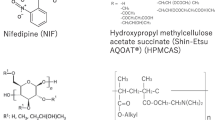Abstract
Purpose. (a) To improve the absorption of sulpiride (SP) through the intestinal wall by incorporating it together with sodium decanoate (SD) into erodible matrices, designed to synchronize the release of SP and SD over different periods of time; (b) to test, in vivo the hypothesis that this simultaneous release increases SP absorption from the intestinal lumen.
Methods. Matrix tablets, possessing different erosion rates, were prepared by changing the ratios between SD and hydroxypropyl methylcellulose (HPMC). The amounts of HPMC varied from 2.5% to 17% w/w. Double layer tablets, containing similar amounts of SP, SD, and HPMC were used as nonsynchronous controls. The erosion kinetics of the tablets was assessed gravimetrically in vitro in USP basket dissolution apparatus and in vivo in the intestine of the anesthetized rat after intra-intestinal administration. SP absorption was studied after intra-intestinal administration of the different kinds of tablets to anesthetized rats, by monitoring SP blood levels. SP and SD levels in the withdrawn samples from the dissolution systems and blood were analyzed by HPLC.
Results. The controlled erosion of the tablets resulted in equal release rates of SP and SD during the initial linear phase of the process. This synchronized release lasted over different time periods depending on the relative amount of HPMC in the formulations (from 1 hour to 4 hours for 2.5 and 17 % w/w of HPMC, respectively). The synchronous matrices increased SP bioavailability after intra-intestinal administration. The increase varied from 1.4 to 2.3-fold for the slow and the fast release formulations, respectively (compared with the nonsynchronous, SD containing control formulations), indicating the ability to control both erosion rate and length of intestinal segment in which absorption is taking place.
Conclusions. SP bioavailability after intestinal administration can be improved only if SP is released together with SD along the entire intestinal route. This can be accomplished by the design of synchronous matrices capable of concomitant release of SP and SD despite the differences in their water solubility. The ability to manipulate and control the duration of the synchronous phase of the matrices makes it possible for SP to be absorbed at different parts of the intestine.
Similar content being viewed by others
REFERENCES
M. Ishida, Y. Machida, N. Nambu, and T. Nagai. New mucosal dosage form of insulin. Chem. Pharm. Bull. 29:810–816 (1981).
H. Bar On, E. M. Berry, A. Eldor, M. Kidron, D. Lichtenberg, and E. Ziv. Enteral administration of insulin in the rat. Br. J. Pharmacol. 73:21–24 (1981).
T. Nishihata, G. Liversidge, and T. Higuchi. Effect of aprotinin on the rectal delivery of insulin. J. Pharm. Pharmacol. 35:616–617 (1983).
I. Naasani, N. Kohri, K. Iseki, and K. Miyazaki. Improving the oral bioavailability of sulpiride by sodium oleate in rabbits. J. Pharm. Pharmacol. 47:469–473 (1995).
S. Muranishi. Modification of intestinal absorption of drugs by lipoidal adjuvants. Pharm. Res. 108–118 (1985).
S. Muranishi. Absorption enhancers. Crit. Rev. Ther. Drug Carriers Sys. 7:1–33 (1990).
A. Sintov, M. Simberg, and A. Rubinstein. Absorption enhancement of captopril in the rat colon as a putative method for capropril delivery by extended release formulations. Int. J. Pharm. 143:101–106 (1996).
M. Shameem, N. Katori, N. Aoyagi, and S. Kojima. Oral solid controlled release dosage forms: role of GI-mechanical destructive forces and colonic release in drug absorption under fasted and fed conditions in humans. Pharm. Res. 12:1049–1054 (1995).
S. F. Phillips. Integration of secretory and absorptive function. Mayo Clin. Proc. 48:630–633 (1973).
M. Baluom, M. Friedman, and A. Rubinstein. The importance of intestinal residence time of absorption enhancer on drug absorption and implication on formulative considerations. Int. J. Pharm. 176:21–30 (1998).
F. Bressolle, J. Bres, and A. Faure-Jeantis. Absolute bioavailability, rate of absorption and dose proportionality of sulpiride in humans. J. Pharm. Sci. 81:26–32 (1992).
N. Kohri, I. Naasani, K. Iseki, and K. Miyazaki. Improving the oral bioavailability of sulpiride by a gastric-retained form in rabbits. J. Pharm. Pharmacol. 48:371–374 (1995).
N. Mizuno, E. Morita, M. Nishikata, D. Shinkuma, and Y. Yamanaka. Gastrointestinal absorption of sulpiride in the rat. Arch. Int. Pharmacodyn. 283:30–38 (1986).
M. Hayashi, T. Sakai, Y. Hasegawa, T. Nishikawahara, H. Tomioka, A. Iida, N. Shimizu, M. Tomita, and S. Awazu. Physiological mechanism for enhancement of paracellular drug transport. J. Control Rel. 62:141–148 (1999).
E. K. Anderberg, T. Lindmark, and P. Artursson. Sodium caprate elicits dilatation in human intestinal tight junctions and enhances drug absorption by the paracellular route. Pharm. Res. 10:857–864 (1993).
I. Lutsky, F. Aizer, and N. Mor. The Sabra rat: Definition of a laboratory animal. Is. J. Med. Sci. 20:603–612 (1984).
J. Hochman, and P. Artursson. Mechanism of absorption enhancement and tight junction regulation. J. Control Rel. 29:253–267 (1994).
E. J. van Hoogdalem, A. M. Stijnen, A. G. De Boer, and D. D. Breimer. Rate-controlled absorption enhancement of rectally administered cefazolin in rats by a glyceride mixture (MGK). J. Pharm. Pharmacol. 40:329–332 (1988).
E. J. van Hoogdalem, M. A. Hardens, A. G. de Boer, and D. D. Breimer. Absorption enhancement of rectally infused cefoxitin sodium by medium-chain fatty acids in concious rats: Concentration-effect relationship. Pharm. Res. 5:453–456 (1988).
T. Kimura, K. Sato, K. Sugimoto, R. Tao, T. Murakami, Y. Kurosaki, and T. Nakayama. Oral administration of insulin as poly-(vinyl alcohol)-gel spheres in diabetic rats. Biol. Pharm. Bull. 19:897–900 (1996).
Y. Kimura, T. Lindmark, and P. Artursson. Regulation of immediate and long term effects of the absorption enhancer sodium caprate in human intestinal epithelial (CACO-2) cells. Proceed. Intern. Symp. Control. Rel. Bioact. Mater., Kyoto, Japan, 1996.
P. Colombo, R. Bettini, P. Santi, A. De Ascentiis, and N. A. Peppas. Analysis of the swelling and release mechanisms from drug delivery systems with emphasis on drug solubility and water transport. J. Control Rel. 39:231–237 (1996).
B. Tirosh, M. Baluom, T. Nassar, M. Friedman, and A. Rubinstein. The effect of Eudragit RL-100 on the mechanical and mucoadhesion properties of polycarbophil dosage forms. J. Control Rel. 45:57–64 (1997).
K. Takahashi, T. Murakami, A. Kamata, R. Yumoto, Y. Higashi, and N. Yata. Pharmacokinetic analysis of the absorption enhancing action of decanoic acid and its derivatives in rats. Pharm. Res. 11:388–392 (1994).
N. Katori, N. Aoyagi, and T. Terao. Estimation of agitation intestity in the GI tract in humans and dogs based on in vitro/in vivo correlation. Pharm. Res. 12:237–243 (1995).
Author information
Authors and Affiliations
Rights and permissions
About this article
Cite this article
Baluom, M., Friedman, M., Assaf, P. et al. Synchronized Release of Sulpiride and Sodium Decanoate from HPMC Matrices: A Rational Approach to Enhance Sulpiride Absorption in the Rat Intestine. Pharm Res 17, 1071–1076 (2000). https://doi.org/10.1023/A:1026449527891
Issue Date:
DOI: https://doi.org/10.1023/A:1026449527891




